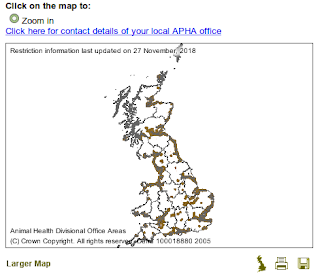 |
| Credit DEFRA |
#13,703
While bird flu activity in Europe (aside from Bulgaria) has been subdued for months, with winter's approach DEFRA yesterday issued another reminder of the risk of avian flu carried to the UK via migratory and overwintering birds.
New in this report is a link to an updated interactive map of Higher Risk Areas (HRAs) - areas near lakes, marshes or estuaries - where birds tend to gather (see below).
Higher Risk Areas (HRAs)
All areas in Great Britain remain at risk of bird flu in wild birds.
However, in Great Britain we’ve defined a number of areas as ‘Higher Risk Areas’ (HRAs). These are generally areas near where wild birds (and in particular gulls and wild waterfowl) gather, such as lakes, marshes or estuaries.
Check if your premises is within an HRA on our interactive map.
If all or part of your premises is in a Higher Risk Area you should follow biosecurity advice to protect your birds. We consider that you’re in an HRA even if only part of your premises falls within the HRA.
We have defined HRA’s following our experience over the last 2 winters, coupled with the latest scientific and veterinary opinion. This indicates that migratory wild waterfowl (ducks, geese and swans) and gulls pose a continual threat for the introduction of bird flu into premises where poultry, game birds, pet and other captive birds are kept. EU regulations require that member states identify areas of the country where the risk of bird flu is deemed to be highest. We have published more detail of the rationale and approach behind Higher Risk Areas.
If you are planning a new poultry unit you should take into account the risk of HPAI where the unit is planned.
As mentioned above, DEFRA has published a 22-page rational for determining HRAs around the UK (see below). Due to its length, I've only excerpted a small portion. Follow the link to download and read the full report.
Disease risk considerations supporting the definition of Avian Influenza Higher Risk Areas in England, Scotland and Wales
November 2018
Summary
Great Britain (GB) has a variable risk of incursion (in wild birds and/or poultry) of notifiable avian disease throughout the year and the risk for avian influenza is generally heightened in the winter season when migratory wild waterfowl are arriving at their over-wintering sites across GB. A range of species, including, ducks, geese, swans and gulls are considered to act as reservoirs of avian influenza viruses (AIV).
The heightened probability of GB poultry contact with wild birds in autumn/winter means we consider there may be a corresponding heightened risk of AIV exposure to poultry, but this would depend on the level of infection in the wild birds and the nature of the virus itself, which may not “jump” readily into poultry.
Therefore and in accordance with the EU legislation (Commission Decision (EU) 2018/1136) we have conducted an analysis of higher risk areas across GB where the probability of finding wild birds infected with avian influenza viruses is greater at certain times of the year.
Expert analyses have taken place of 1) the disease introductions into the UK and across Europe, 2) the evidence from the widespread surveillance to date across Europe, 3) the wild bird species where infection has been identified and 4) the risk factors associated with spread from wild birds to domestic poultry identified. This has led to an understanding that “higher risk areas” may be identified within the country. Typically these are close to inland or coastal bodies of water, where large numbers of wild birds collect, with wild waterbirds, specifically duck species, being highlighted.
The presence of virus in the environment surrounding a poultry farm means it can be carried into the farm by various means, bridging species (birds visiting both poultry farms and waterbird areas), such as gulls and corvids, humans, equipment, rodents etc.
Therefore the closer a poultry premises is to locations where high numbers of potentially infected wild birds are present, the greater is the risk that disease will be carried into it by one of these pathways. The level of risk reduces as the distance from wild bird resting places increases, as the likelihood of somehow bringing contamination into the farm is considered to decline. Hence whilst best practice biosecurity must be practised in all areas of the country, in these higher risk areas, biosecurity protective measures may need to be enhanced at certain times of the year.
Housing or covering areas with netting where domestic poultry are kept or range should therefore continue to protect farms in these higher risk areas. Published studies indicate that a distance of 5km from such bodies of water would exceed the likely maximum daily foraging distance of most duck species and therefore be the proposed edge for Higher Risk Area, however 2km foraging distance would cover the majority of the spatial risk. The risk of contact with bridging species, such as gulls and corvids, exists for all areas of GB and therefore general biosecurity awareness for poultry keepers are necessary in all areas of GB.
(Continue . . . )
Last April, in ESA Epidemiological Update: Global Circulation Of Avian Flu, we looked at the general pattern of avian flu outbreaks around the world, and the tendency for years with high levels of activity to be followed by one or more years of lesser activity.
 |
| From ESA Report |
Based the above chart, 2006, 2008, 2014-15, and 2016-17 were all high activity periods, with a highly noticeable 6 year quiescent period between 2009 and late 2014. In contrast, two shorter gaps are shown (2007 & 2015-17), illustrating the unpredictability of avian flu.
At this point - as with seasonal flu - we can't really predict what this winter will bring. The best we can hope for is to be prepared to deal with whatever comes.
